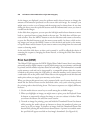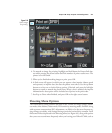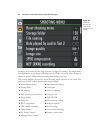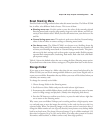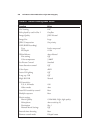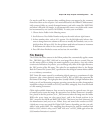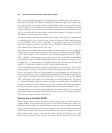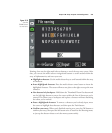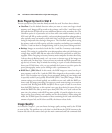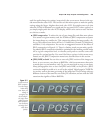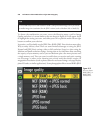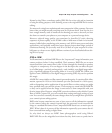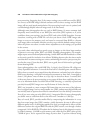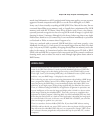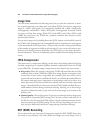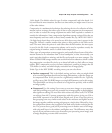Role Played by Card in Slot 2
You can specify how you want that handy second slot used. You have three choices:
■ Overflow. Use this default function when you want to create one larger virtual
memory card. Images will be stored to the primary card in Slot 1 until that card is
full, and then the D7000 will save any additional photos to the secondary slot. The
Overflow option is of particular use to those who own smaller memory cards (a
2GB card will fill up rather quickly), and sports/photojournalism photographers,
who typically swap out memory cards when they are 80-90 percent full, to avoid
losing an important shot during a changeover. The Overflow setting allows using
the primary card to its full capacity, with the secondary card taking over seamlessly.
The Slot 1 card can then be changed during a lull in your picture taking activities.
■ Backup. Images are recorded to both the Slot 1 and Slot 2 memory cards simulta-
neously. This setting is a godsend for event photographers who can’t risk losing even
a single shot, and for folks like me who travel extensively specifically to take pho-
tographs. When I’m going to be away from my main computer for more than a day,
I always shoot in Backup mode, so I can create an instant copy of the images on
my main card. On short trips, I can even leave my netbook and PSD (personal stor-
age device) at home. Keep in mind that writing to a pair of cards simultaneously
slows your D7000 down a bit, so you probably don’t want to use this option for
sports photography, unless you’re willing to take a performance hit.
■ RAW Slot 1, JPEG Slot 2. In this mode, the RAW images are stored on the pri-
mary memory card in Slot 1 and the JPEG files relegated to the secondary card in
Slot 2. This is another way of giving you an automatic backup of your images, and
is especially useful if you typically shoot RAW+JPEG. Your JPEG images, with the
camera settings you selected applied, are available on one card, while the RAW ver-
sions, ready for image processing if you want to tweak some settings, are stored on
a second card. Writing both RAW and JPEG files to a pair of cards is even slower
than dual JPEG backups, so this option is not your best choice for sports. Keep in
mind that RAW files take up more space than JPEG files, so if your cards are the
same size, the primary card will fill up more quickly. (A partial solution is to use a
larger card as your primary, and a smaller one for the secondary.) When using this
mode, the D7000 reports the number of shots remaining for the card with the least
amount of space left, and if either card fills, the shutter release locks.
Image Quality
As I noted in Chapter 1, you can choose the image quality settings used by the D7000
to store its files. The quickest way to do that is to hold down the QUAL button on the
bottom-left side of the camera and spin the main command and sub-command dials
David Busch’s Nikon D7000 Guide to Digital SLR Photography234



